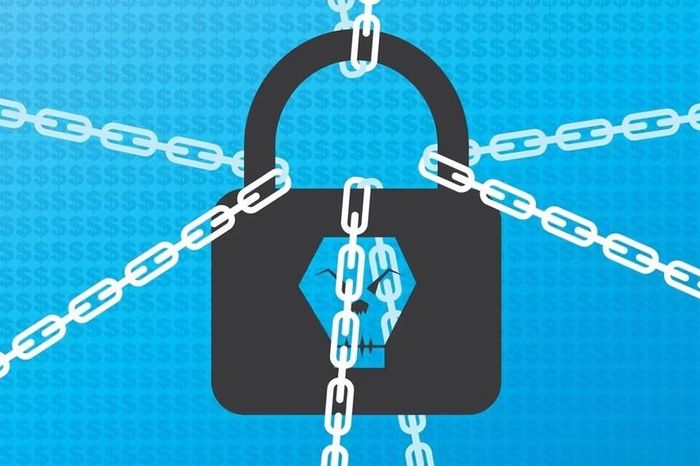Famous cyber attacks of the past decade
Two basic forms of ransomware
Ransomware attack is a form of hackers using ransomware to encrypt and control access to important assets in a business's information technology system in order to demand a ransom to restore rights. access that. Talking to VTC News, Ms. Vo Duong Tu Diem, Vietnam Regional Director of Kaspersky, said that to protect businesses, users need to distinguish two basic types of ransomware:
Locker ransomware : This form will partially disable the user's mouse and keyboard, but still allow them to see the ransom request screen. However, other functions of the computer will not be available.
Crypto ransomware : Instead of blocking basic computer functions, this malware encrypts critical business data, such as information about customers, partners, supply chains, employees, and strategies. Business strategies, images, videos. Attackers take advantage of the importance of data to demand ransom, otherwise all important information will be deleted.
The common characteristic of ransomware attacks is that hackers have infiltrated the database for a long time and are hidden here, without creating any suspicious activities in order to bypass the supervision of organizations and businesses. Karma. They will "lay low" long enough to grasp the importance and scale of the information, and when the time is ripe, they will encrypt the most important data to force the victim to pay the ransom.

Typical cyber attacks
Over the past decade, cyber criminals have caused ransomware attacks and used many methods to spread malicious code into the information systems of many different businesses and organizations globally, not just Vietnam. Male. Below are some typical examples of the dangers and risks that ransomware attacks pose to businesses:
Email phishing attacks : In 2016, a series of ransomware attacks called Locky targeted large hospitals, leaving these facilities unable to access patient data. In some cases, they are forced to transfer patients to other hospitals. Typically, victims are scammed via email and this attack encrypts all important documents and images, for example patient records, until the ransom (usually Bitcoin or other cryptocurrency) is paid. valuable and highly stable element) is paid.
Operating system vulnerabilities : Outdated systems are one of the main reasons why businesses are vulnerable to ransomware attacks, typically the famous ransomware infection campaign called WannaCry in 2017. This attack started in the UK and spread to nearly 150 countries worldwide, mainly targeting state agencies and large businesses. According to Interpol, WannaCry malware has attacked 230,000 computers in 150 countries. As a result, the Telefonica phone network in Spain was paralyzed and the departure schedules of many trains and ticket vending machines were seriously disrupted.
"Drive-by-attacks" : After the WannaCry ransomware incident in 2017, another type of ransomware called Bad Rabbit appeared, mainly targeting countries such as Russia and Eastern Europe. The tricks of the hacker group spreading Bad Rabbit are very sophisticated: they require users to run the Adobe Flash installer (actually disguised malware) from a website that has been previously attacked. After completing the installation, the malware begins to infect the user's computer. The attacker demanded a ransom of 0.05 Bitcoin, equivalent to 280 USD at the exchange rate at that time.
Recommendation from experts
Following the recent ransomware attack, security experts offer these recommendations to help businesses protect themselves against similar attacks:
Data backup: Make sure business data is always backed up to prevent it from being lost, stolen or accidentally deleted. When backing up, use external devices and disconnect them from the computer immediately afterward because data will be encrypted if it remains connected to the malware-infected device. Backing up will help businesses avoid data loss and ransom demands.
Update systems regularly: The 2017 WannaCry attack occurred largely because businesses did not update their systems regularly. This allows attackers to exploit the vulnerability. As a result, these vulnerabilities still exist and can be attacked.
Invest in cyber security training for employees: Employees who are fully equipped with cyber security knowledge will be able to respond to cyber attacks. Businesses should invest in training programs to raise employee awareness to help them effectively protect cybersecurity.
Use network security solutions: There are currently many software solutions from reputable security firms (foreign as well as Vietnamese) that can help detect and protect information systems and users from attacks. ransomware attacks at every stage of the attack thanks to a multi-layered security system.
You should read it
- Ransomware can encrypt cloud data
- General guidelines for decoding ransomware
- What is Ransomware Task Force (RTF)?
- [Infographic] 7 effective ways to protect businesses from Ransomware
- How to decode ransomware InsaneCrypt (Everbe 1.0)
- Why is Ransomware the perfect hack?
- Learn about Ransomware: 6 ransomware on computers
- Detecting two unusual versions of ransomware, shows that the world of ransomware has become diversified
May be interested
- Most cyber attacks focused on these 3 TCP ports only
 small and medium-sized businesses can fully protect themselves from most cyber attacks by increasing defenses against ports that are most often targeted by malicious actors.
small and medium-sized businesses can fully protect themselves from most cyber attacks by increasing defenses against ports that are most often targeted by malicious actors. - Common types of cyber attacks target seniors
 cybercrime targeting the elderly is a major problem worldwide. there are many reasons for this group to fall victim to online fraud. the majority of the elderly access technology era slower than young people
cybercrime targeting the elderly is a major problem worldwide. there are many reasons for this group to fall victim to online fraud. the majority of the elderly access technology era slower than young people - What are Volumetric Attacks? How to Detect and Prevent Them Effectively
 volumetric attacks are a type of cyber attack that falls under the category of ddos (distributed denial of service). attackers will send large amounts of unwanted data to a specific target in order to overload that system.
volumetric attacks are a type of cyber attack that falls under the category of ddos (distributed denial of service). attackers will send large amounts of unwanted data to a specific target in order to overload that system. - Defeat China's largest hacker training furnace
 chinese police have closed the website to recruit thousands of members and provide training on cyber attacks and malicious code.
chinese police have closed the website to recruit thousands of members and provide training on cyber attacks and malicious code. - Game industry - an attractive target for cyber criminals
 the explosive growth of the unseen gaming industry has caused this billion-dollar industry to 'get' more attention from cyber criminals.
the explosive growth of the unseen gaming industry has caused this billion-dollar industry to 'get' more attention from cyber criminals. - What is cyber bullying? How to prevent cyber bullying
 abusers and social problems have been around for a long time, but technology now gives them a whole new platform that is in line with their actions.
abusers and social problems have been around for a long time, but technology now gives them a whole new platform that is in line with their actions. - More than 1.7 billion cyber attacks in 2013
 mobile is a fast growing it sector. in 2013, security issues around mobile devices have reached a new level of increase in both quantity and quality. if 2011 was the year the mobile malware started to attract attraction to hackers, then in 2013, these malicious software became more complete and sophisticated.
mobile is a fast growing it sector. in 2013, security issues around mobile devices have reached a new level of increase in both quantity and quality. if 2011 was the year the mobile malware started to attract attraction to hackers, then in 2013, these malicious software became more complete and sophisticated. - Another large Data Center service provider became a victim of ransomware
 ransomware appears to be redirecting attacks to major data centers on a global scale.
ransomware appears to be redirecting attacks to major data centers on a global scale. - What do you know about the first 'cyber attack' in the world?
 temporarily restraining the 'contemplative' reality of today's global cyber security, we try to go back too much to the early days of the concept of 'cyber attack'. do you know when the world's first cyber attack occurred?
temporarily restraining the 'contemplative' reality of today's global cyber security, we try to go back too much to the early days of the concept of 'cyber attack'. do you know when the world's first cyber attack occurred? - 3 types of dangerous cyber attacks in 2021
 ransomware, phishing messages, and phishing emails will be the types of attacks that will be faced by small and medium businesses (smes) this year.
ransomware, phishing messages, and phishing emails will be the types of attacks that will be faced by small and medium businesses (smes) this year.










 Is it possible to 'crack' ransomware?
Is it possible to 'crack' ransomware? Detection of Windows SmartScreen vulnerability being exploited to spread DarkGate malware
Detection of Windows SmartScreen vulnerability being exploited to spread DarkGate malware Serious vulnerability helps hackers attack Facebook accounts without the victim's actions
Serious vulnerability helps hackers attack Facebook accounts without the victim's actions How are scammers using your face to commit fraud?
How are scammers using your face to commit fraud? The new attack technique uses a wireless charger to issue voice commands and heat up the device
The new attack technique uses a wireless charger to issue voice commands and heat up the device New malware discovered that can bypass Windows SmartScreen and steal user data
New malware discovered that can bypass Windows SmartScreen and steal user data